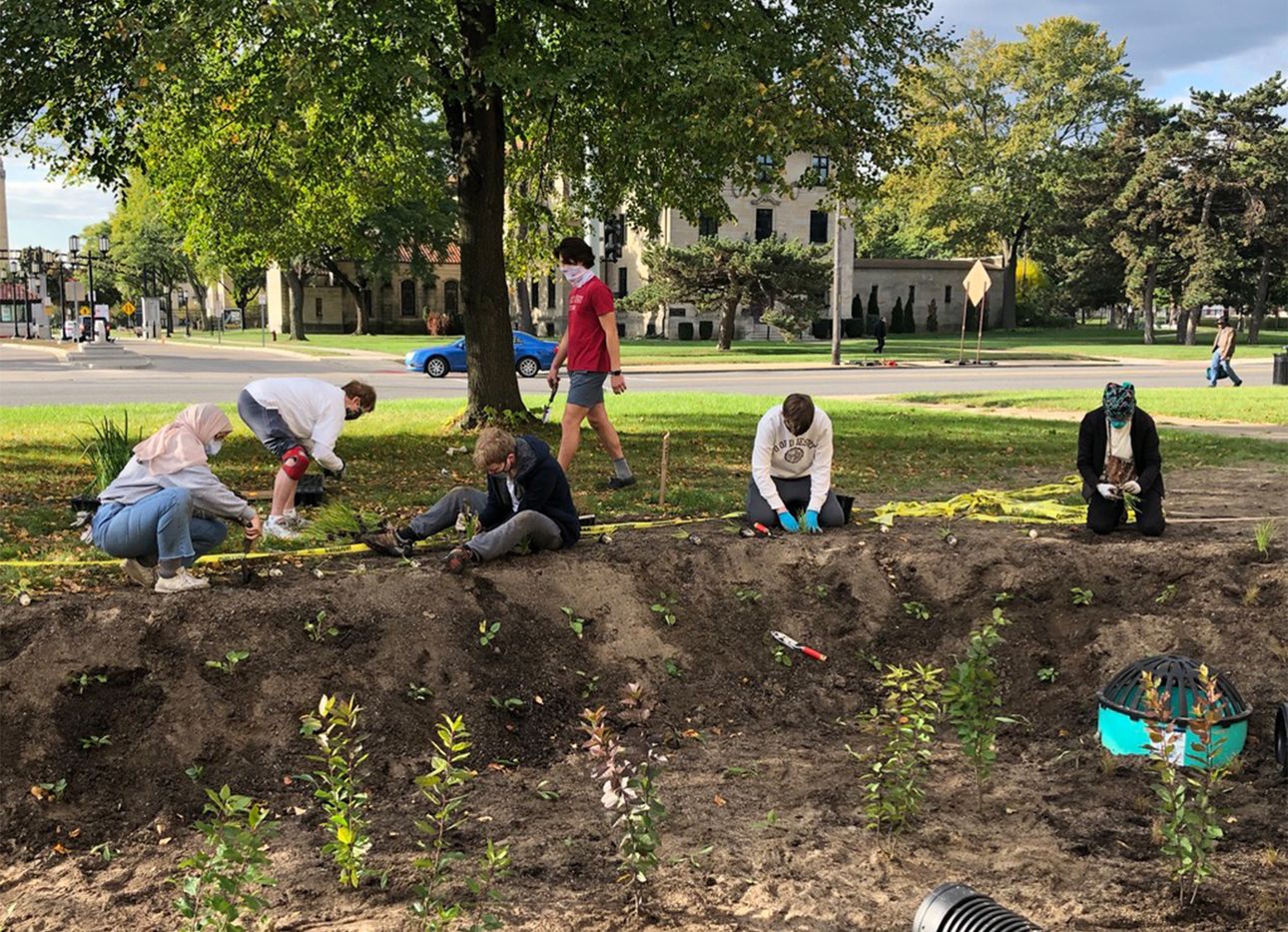
A National Garden Program Connects Faith With the Environment, in Detroit and Beyond
Two years ago, outside Christ the King Catholic Church, in northwest Detroit, a flurry of congregants’ hands were at work, digging, weeding, and watering. Slowly but surely, a special kind of garden was taking shape: one that centered around plant species native to the region. Located just a mile from the River Rouge, which flows from the Metro Detroit area into the Detroit River, the patch doubles as a rain garden, drinking up stormwater runoff from the church’s roof and downspouts. This orientation allows the water to percolate through the garden soil rather than into Detroit’s sewers, which, during particularly precipitous times of year, are known to overflow and pollute nearby waterways.
The 95-year-old church’s garden—which will be joined by another later this month—is part of an expanding network of sites participating in Sacred Grounds, a program run by the National Wildlife Federation (NWF) that helps houses of worship transform a portion of their properties into outdoor oases for wildlife by growing native plants. This type of greenery plays an essential role in any locale: Since a given region’s flora and fauna develop together, certain species can only feed on plants they co-evolved with. Without them, gardens become ecological deserts for pollinating insects, which are essential for the survival of all terrestrial ecosystems. Native plants also provide vital food, shelter, and places to rear offspring for songbirds, and, thanks to their local roots, often thrive year-round.
First conceived a decade ago by Naomi Edelson, NWF’s senior director of wildlife partnerships, the program now has regional hubs in the Mid-Atlantic, Great Lakes, and South Central regions of the United States, with other gardens cropping up elsewhere nationwide. More than 100 congregations have joined the program to date, comprising a diverse membership spanning Judaism, Islam, Christianity, Buddhism, and Indigenous faiths. By design, Sacred Grounds is a communal effort. To participate, churches must create some form of wildlife habitat with native plants, as well as educate and engage their congregation, and surrounding neighborhoods, in the practice. Once inducted as a Sacred Grounds member, a church can apply for grants to receive funding, a native plant starter kit, and—if its congregation is located in one of Sacred Grounds’ regional hubs—on-site guidance and assistance.
Houses of worship have turned out to be apt vehicles for getting the word out about safeguarding the environment, as most serve as beacons in their locales, exercise a wide reach, and are situated on large swathes of land. “Faith leaders are really passionate about community revitalization, community empowerment, and lifting people up,” says Tiffany Carey, NWF’s education and engagement manager. Edelson, the program’s partnerships director, says that the esteem that faith leaders often hold in their districts goes a long way, too. “They’re well respected,” she says. “So having them connect faith and the environment, as superior figures in their communities, is very powerful.”
More than just a way to revitalize a congregation’s surroundings, the program also prompts a turning inward, reinvigorating the spiritual identities of the congregants themselves. “The Sacred Grounds initiative is such a logical and appropriate idea because different faiths are united in their notion that God is creator, and that we, as one of the creations, need to band together to protect creation for the glory of the Creator,” says Rabbi Fred Scherlinder Dobb of the Adat Shalom Reconstructionist Congregation in Bethesda, Maryland. “We connect the sacred grounds, and we create islands of sustainability, because we are people of faith.”
When it comes to the planting itself, NWF helps congregations strategize to account for their community’s landscaping preferences, the needs of area pollinators and wildlife, and the demands of the local climate. In Detroit, for instance, plants with deep root systems are needed to protect against flooding. At the city’s Gesu Catholic Church, perennial flowers and grasses, including Black-eyed Susans, wild strawberries, and Indian grass fill the garden beds, while the plot at the nearby Pure in Heart Missionary Baptist Church brims with coneflower, ivory halo dogwood, crocuses, woodland sage, Allegheny serviceberry, and red tulips. Across the country, keystone plants—organisms specific to local food webs within ecoregions—known to attract caterpillars, take priority. (Caterpillars, in turn, draw nesting birds, such as chickadees, which act as key pollinators.)
Ultimately, Sacred Grounds’s impact transcends the fragrant flowers, the habitat creation, and even the community building. The relationship between faith and the environment is one that has long been entangled with controversy and political beliefs—a straddle of sorts across party lines. By working hand in hand with houses of worship that encompass multiple belief systems, and by guiding them through education and expertise, Sacred Grounds takes environmentalism back to its uncomplicated roots: an effort to take care of our shared home, and to treat the earth with the reverence it deserves.